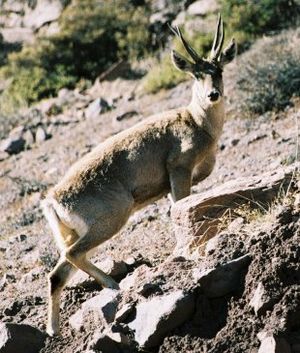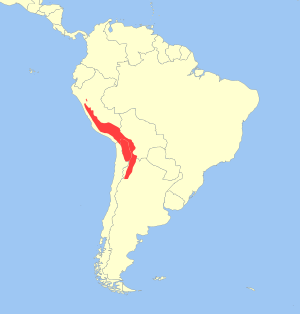Taruca facts for kids
Quick facts for kids Taruca |
|
|---|---|
 |
|
| Conservation status | |
| Scientific classification | |
| Genus: |
Hippocamelus
|
| Species: |
antisensis
|
 |
|
| Geographic range | |
The taruca (Hippocamelus antisensis) is a special type of deer. It's also called the Peruvian guemal or northern huemul. This medium-sized deer lives high up in the Andes mountains of South America. The name "taruca" means "deer" in both the Quechua and Aymara languages. The taruca is very similar to the southern guemal. These two are the only members of the Hippocamelus group of deer.
Contents
What Does a Taruca Look Like?
The taruca is a medium-sized deer with a strong, heavy body. From its head to its rump, it measures about 128 to 146 centimeters (50 to 57 inches). Its tail is short, only about 11 to 13 centimeters (4 to 5 inches) long. At the shoulder, a taruca stands 69 to 80 centimeters (27 to 31 inches) tall. Adult tarucas weigh between 69 and 80 kilograms (152 to 176 pounds). Just like many other deer, male tarucas are usually bigger than females.
Female tarucas often have a dark brown spot on their forehead. However, the markings on the faces of male tarucas are much clearer. These patterns are different for each male. Generally, males have a black mask behind their nose. They also have a black Y or V shape over their forehead and snout.
Taruca Antlers and Teeth
Only male tarucas typically grow antlers. The longer part of a fully grown male's antler is usually around 30 centimeters (12 inches) long. Unlike most other South American deer, except for the closely related huemul, taruca antlers have only two points. These points branch out from the base. The back point is the larger one. Male tarucas also have canine teeth in their upper jaw. Females usually do not have these teeth, but sometimes they do.
Where Do Tarucas Live?
Tarucas are found only in the Andes mountains. Their home stretches from central Peru, through Bolivia and the very north-eastern part of Chile. They also live in northern Argentina.
Peru has the largest number of tarucas in South America. In 2008, experts thought there were between 9,000 and 12,000 tarucas. They live across the central Andes mountains. The Huancabamba Depression is the northernmost place where tarucas are found. Tarucas live at very high elevations, from 3,500 meters (11,500 feet) up to 5,000 meters (16,400 feet). At lower parts of this range, they might share their land with the Peruvian whitetail deer. These deer also live only in this area. In Argentina, tarucas live at heights of 2,000 meters (6,600 feet) to 3,000 meters (9,800 feet). Here, they live in grasslands with some shrubs and rocky areas. They usually stay close to water. There are no different types or subspecies of tarucas known.
What Do Tarucas Eat and How Do They Behave?
Tarucas mostly live on rocky slopes, in queñual forests, and in puna grasslands. These areas are often next to glacier lakes in high mountain regions. Even though they live in grasslands, tarucas mostly eat local bushes, shrubs, and herbs for most of the year. During the rainy season, they also eat grasses. Some plants they commonly eat include dwarf gentian, ragworts, lupins, senna, valerian, and clubmosses. Tarucas might also eat farm crops like alfalfa, barley, and potato plants.
Tarucas like to be in groups, but these groups don't stay the same. Individuals move between groups that can have up to thirty members. Their populations are spread out because they need special places to live. There might be as few as 0.15 tarucas per square kilometer, even away from people. Female tarucas usually lead the groups. During the time they breed, male tarucas might fight each other. They show off by lifting one front leg at a time and pointing their antlers at each other.
Taruca Life Cycle and Reproduction
The breeding season for tarucas is from May to July. During this time, the deer split into smaller groups, each with one adult male. Males lose their antlers right after the breeding season ends, in September. New antlers start to grow in December and lose their soft covering (velvet) by February. Pregnancy lasts for 240 days. This means the single baby taruca, called a fawn, is born between January and March. This time matches the rainy season. Sometimes, twins have been seen when tarucas are kept in zoos, but this is rare in the wild. The mother leaves her group to give birth. She keeps her fawn hidden behind rocks for the first month of its life.
See also
In Spanish: Taruca para niños


